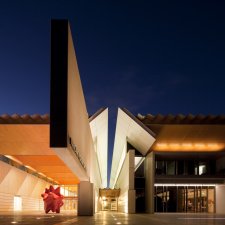- About us
- Support the Gallery
- Venue hire
- Publications
- Research library
- Organisation chart
- Employment
- Contact us
- Make a booking
- Onsite programs
- Online programs
- School visit information
- Learning resources
- Little Darlings
- Professional learning
Jeffrey Smart (1921–2013) was an iconic realist painter, acclaimed for his urban and industrial landscapes which form one of the most original and recognisable bodies of work in the canon of Australian art. He created a distinctive style that captured the stillness and alienation of the industrialised world with metaphysical nuance and a refined, crisp clarity of vision. Born in Adelaide in 1921, Smart studied part-time at the South Australian School of Arts and Crafts under Marie Tuck and Rupert Bunny in the late 1930s. Influenced by modernist artist Dorrit Black, Smart acquainted himself with the 'Golden Mean', a ratio used to create mathematically-sound proportions that translated into artistic composition. This geometric proportion ratio has been used since ancient Greek times in many works of art and architecture. Smart used the complex network of interlocking rectangles, triangles and diagonals to calculate the structure of his paintings and form the basis of all of his artworks.
Smart began exhibiting in group shows in the early 1940s and had his first solo exhibition in Melbourne in 1944, opened by Robert Menzies. In 1948, Smart travelled to England via the United States. He then went to Paris and studied at the Grande Chaumière before attending the Académie Montmartre, studying under Fernand Leger for six months. Throughout this period he travelled in Europe with Australian friends including Michael Shannon, Jacqueline Hick, Donald Friend and Margaret Cilento. His travels allowed Smart the opportunity to view and study the work of artists he admired – in particular Paul Cezanne, Piero della Francesca, Rogier van der Weyden, Giovanni Bellini, and Titian. On returning to Australia in 1951, Smart settled in Sydney where he lived, worked and exhibited for the next twelve years. During this period, he also worked as an art critic for the Daily Telegraph, as a life drawing teacher at Easy Sydney Technical College, and as the arts correspondent for the ABC children's radio programme the Argonauts Club. In 1964, Smart moved to Italy, initially living in Rome before settling in Arezzo, Tuscany in the early 1970s, and he remained there until his death in 2013.
Despite his relocation to Tuscany, Smart continued to exhibit in Australia where he enjoyed ongoing popular and critical success. During the 1960s, Smart became increasingly dedicated to the representation of the modern city. Each painting was executed with classical precision and included repetitious architectural motifs which reference and were influenced by the flat perspective of Renaissance painting and frescoes. He saw beauty in everyday scenes, choosing to paint highways, factories, trucks, billboards, carparks and vacant city lots in compositions characterised by the play of the shapes, light, shadow and geometry of the urban environment. He once said of his subjects: 'Perhaps I'm trying to help people see the beauty in a gas tank, a road divider, a yellow truck. I paint buildings, factories, freeways, satellite dishes, because I like the definite forms and clean shapes.'
Collection: National Portrait Gallery
Purchased 2012
© Dave Tacon/Copyright Agency, 2024



On one level The Companion talks about the most famous and frontline Australians, but on another it tells us about ourselves.



Visit us, learn with us, support us or work with us! Here’s a range of information about planning your visit, our history and more!



We depend on your support to keep creating our programs, exhibitions, publications and building the amazing portrait collection!